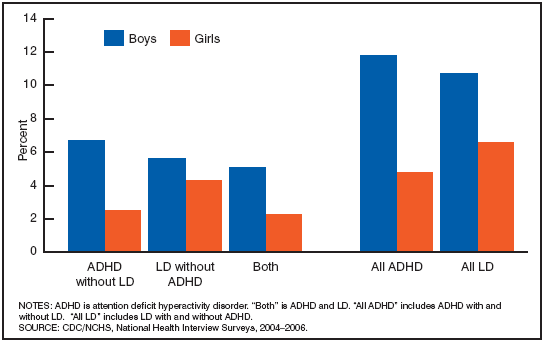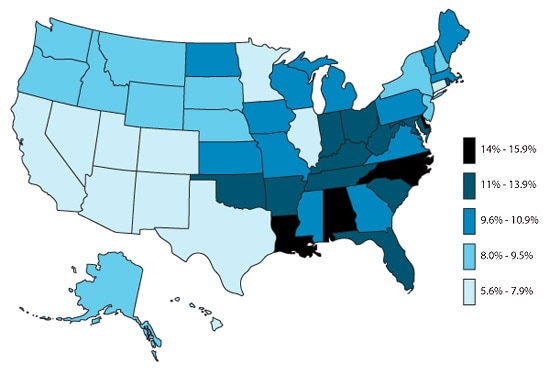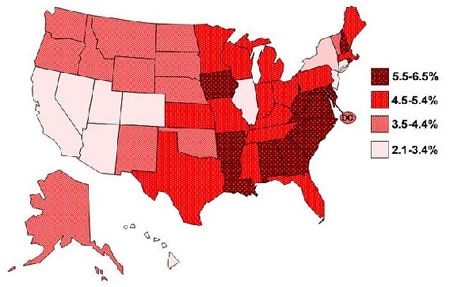Data & Statistics
In the United States
- The American Psychiatric Association states in the Diagnostic and Statistical Manual of Mental Disorders (DSM-IV-TR) that 3%-7% of school-aged children have ADHD. 1Â However, studies have estimated higher rates in community samples.
- Recent data from surveys of parents indicate that:
[Read article]- Â Approximately 9.5% or 5.4 million children 4-17 years of age have ever been diagnosed with ADHD, as of 2007.
- The percentage of children with a parent-reported ADHD diagnosis increased by 22% between 2003 and 2007.
- Rates of ADHD diagnosis increased an average of 3% per year from 1997 to 2006 [Read articleÂ
 ] and an average of 5.5% per year from 2003 to 2007.
] and an average of 5.5% per year from 2003 to 2007. - Boys (13.2%) were more likely than girls (5.6%) to have ever been diagnosed with ADHD.
- Rates of ADHD diagnosis increased at a greater rate among older teens as compared to younger children.
- The highest rates of parent-reported ADHD diagnosis were noted among children covered by Medicaid and multiracial children.
- Prevalence of parent-reported ADHD diagnosis varied substantially by state, from a low of 5.6% in Nevada to a high of 15.6% in North Carolina.
State-based Prevalence Data of ADHD Diagnosis (2007-2008)
Medication Treatment
- As of 2007, 2.7 million youth ages 4-17 years (66.3% of those with a current diagnosis) were receiving medication treatment for the disorder. [Read article]
- Rates of medication treatment for ADHD varied by age and sex; children aged 11-17 years of age were more likely than those 4-10 years of age to take medication, and boys are 2.8 times more likely to take medication than girls [Read article]
- In 2003, geographic variability in prevalence of medication treatment ranged from a low of 2.1% in California to a high of 6.5% in Arkansas. [Read article]
State-based Prevalence Data of ADHD Medication Treatment (2003)
Diagnosed Attention Deficit Hyperactivity Disorder and Learning Disability: United States, 2004-2006

- About 5% of children had ADHD without Learning Disability (LD), 5% had LD without ADHD, and 4% had both conditions.
- Children 12-17 years of age were more likely than children 6-11 years of age to have each of the diagnoses.
- Hispanic children were less likely than non-Hispanic white and non-Hispanic black children to have ADHD (with and without LD).
- Children with Medicaid were more likely than uninsured children or privately insured children to have each of the diagnoses.
- Children with each of the diagnoses were more likely than children with neither ADHD nor LD to have other chronic health conditions.
- Children with ADHD (with and without LD) were more likely than children without ADHD to have contact with a mental health professional, use prescription medication, and have frequent health care visits.
Peer Relationships
- Parents of children with a history of ADHD report almost 3 times as many peer problems as those without a history of ADHD (21.1% vs. 7.3%).
- Parents report that children with a history of ADHD are almost 10 times as likely to have difficulties that interfere with friendships (20.6% vs. 2.0%).
Injury
- A higher percentage of parents of children with attention-deficit/hyperactivity disorder reported non-fatal injuries (4.5% vs. 2.5% for healthy children). [Read article
 ]
] - Children with ADHD, compared to children without ADHD, were more likely to have major injuries (59% vs. 49%), hospital inpatient (26% vs. 18%), hospital outpatient (41% vs. 33%), or emergency department admission (81% vs. 74%). [Read article
 ]
] - Data from international samples suggest that young people with high levels of attentional difficulties are at greater risk of involvement in a motor vehicle crash, drinking and driving, and traffic violations. [Read article
 ]
]
Economic Cost
- Using a prevalence rate of 5%, the annual societal ‘‘cost of illness’’ for ADHD is estimated to be between $36 and $52 billion, in 2005 dollars. It is estimated to be between $12,005 and $17,458 annually per individual. [Read article
 ]
] - There were an estimated 7 million ambulatory care visits for ADHD in 2006. [Read articleÂ
 ]
] - The total excess cost of ADHD in the US in 2000 was $31.6 billion. Of this total, $1.6 billion was for the treatment of patients, $12.1 billion was for all other health care costs of persons with ADHD, $14.2 billion was for all other health care costs of family members with ADHD, and $3.7 billion was for the work loss cost of adults with ADHD and adult family members of persons with ADHD. [Read article
 ]
] - ADHD creates a significant financial burden regarding the cost of medical care and work loss for patients and family members. The annual average direct cost for each per ADHD patient was $1,574, compared to $541 among matched controls. The annual average payment (direct plus indirect cost) per family member was $2,728 for non-ADHD family members of ADHD patients versus $1,440 for family members of matched controls. [Read article
 ]
] - Across 10 countries, it was projected that ADHD was associated with 143.8 million lost days of productivity each year. Most of this loss can be attributed to ADHD and not co-occurring conditions. [Read article
 ]
] - Workers with ADHD were more likely to have at least one sick day in the past month compared to workers without ADHD. [Read article
 ]
]
Footnotes:
- American Psychiatric Association. Diagnostic and Statistical Manual of Mental Disorders: DSM-IV-TR. Washington: American Psychiatric Association, 2000.
This page in
For related articles click:
ADHD Statistics and ADHD Data & Statistics
To view HUNDREDS of articles and videos on ADD/ADHD, go to addrc.org



